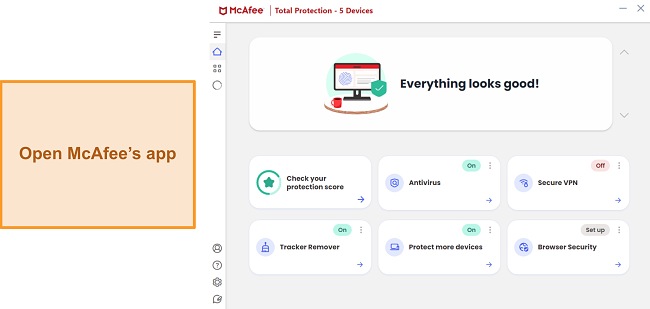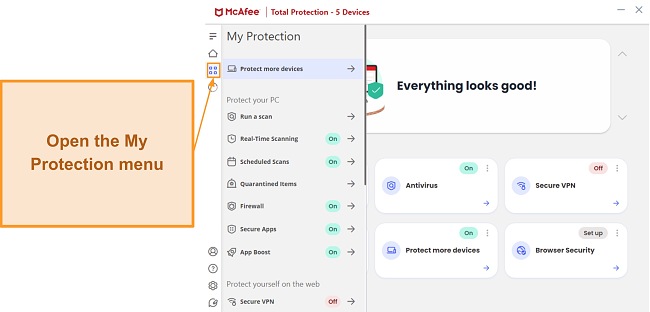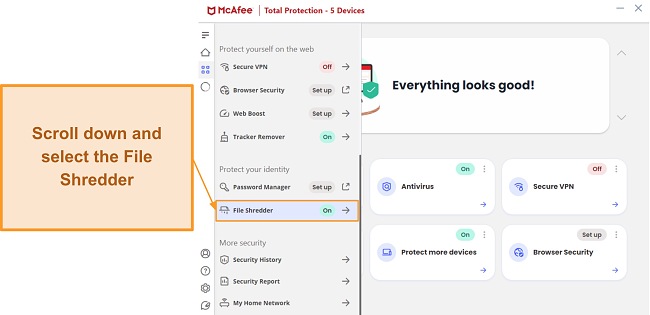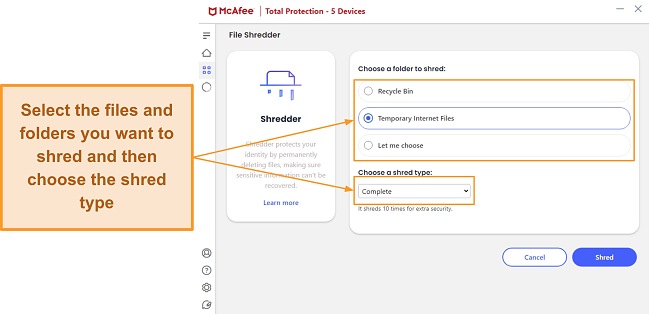McAfee vs Panda: Which Antivirus Is Best? [Updated 2024]
McAfee has been around for decades, but despite being new, Panda is now just as popular. I wanted to see which of these is currently the superior antivirus. So, I tested them against one another across various categories.
I was impressed with how well they both performed, but McAfee outperformed Panda in most cases. McAfee not only offers excellent malware detection rates but is also more feature-rich.
Both options have their strengths and offer 30-day money-back guarantees. McAfee is superior in terms of features and threat detection, but Panda is great if you want a free plan with a reliable virus scanner.
Secure your devices with McAfee
No Time? Here’s a 1-Minute Summary of Category Winners
Panda has a better VPN, and it comes with a free plan, but McAfee outperformed it in almost every other category. McAfee offers 100% threat detection in real-time and through scans, uses system resources more efficiently, and has better parental controls.
| Virus Scanner | Successfully detects and eliminates 100% of malware with its scans | Has an impressive malware detection rate of 99.7% via its scans |
| Real-Time Malware Protection | Offers a 100% detection rate against threats in real-time | Has solid real-time protection, but misses a few threats |
| System Performance | Has a negligible impact on system performance | Can slow your system down sometimes during scans |
| VPN | Has a built-in VPN that offers fast connection speeds | Comes with a reliable VPN powered by Hotspot Shield and is great at streaming |
| Parental Controls | Offers a useful suite of parental controls to safeguard your children | Comes with useful parental controls, but they aren’t as thorough as McAfee’s |
| Firewall | Comes with a secure and customizable built-in firewall | Offers a secure and customizable built-in firewall |
| Password Manager | Intuitive password manager that’s easy to set up and use | Has a built-in password manager, but it’s harder to set up |
| Gaming Mode | Doesn’t have a gaming mode | Comes with a built-in gaming mode |
| Optimization Tools | Offers noticeable performance improvements via its optimization tools | Comes with optimization tools, but they don’t have a significant impact |
| Other Features | Has a variety of additional built-in features like QuickClean, a vulnerability scanner, dark web monitoring, and a file shredding tool | Has useful additional tools like dark web monitoring, anti-theft, and a rescue kit, but isn’t as feature-rich overall |
| Device Compatibility | Works on Android, iOS, macOS, and Windows | Works on Android, iOS, macOS, and Windows |
| Customer Service | Responsive 24/7 customer support through live chat and over the phone | Offers 24/7 phone support but it’s not nearly as responsive or helpful |
| Price | Offers great value for money with each of its plans | Comes with affordable plans but they aren’t the best value for money |
| Free Version | Offers a free trial but doesn’t have a free plan | Comes with a free plan with effective security |
| Money-Back Guarantee | 30-day money-back guarantee | 30-day money-back guarantee |
Try McAfee risk-free for 30 days
How I Tested and Compared McAfee vs Panda
- Virus Scanner — I tested the virus scanning options in both antiviruses to see which one can detect the most malware and threats.
- Real-Time Malware Protection — I checked how effectively the antiviruses safeguarded my system from real-time threats.
- System Performance — I analyzed the impact both antiviruses have on my system’s performance.
- VPN — I checked to see if the antiviruses offer VPNs and whether these VPNs perform well.
- Parental Controls — I looked to see if these antiviruses offer parental controls and whether these controls are effective at keeping kids safe.
- Firewall — I tested both antiviruses to see if they come with built-in firewalls and how secure these firewalls are.
- Password Manager — I checked if the antiviruses offer password managers and if these password managers can keep your credentials safe.
- Gaming Mode — I navigated through both antiviruses to see if they have gaming modes and checked to see if these modes have a visible performance benefit.
- Optimization Tools — I tried out the available optimization tools in the antiviruses to see if they enhance system performance.
- Other Features — I checked which antivirus has more features to offer alongside the usual threat and malware protection.
- Device Compatibility — I researched both antiviruses to see which program works on a wider variety of devices.
- Customer Service — I contacted both antivirus customer support to see how helpful and responsive they are.
- Price — I compared the various available plans for both antiviruses to check which one offers better value for money.
- Free Version — I checked whether these antiviruses offer free plans and whether these free plans are useful.
- Money-Back Guarantee — I researched the money-back guarantees for both antiviruses and checked whether they live up to them.
Safeguard your system with McAfee
1. Virus Scanner — McAfee Successfully Detects and Eliminates All Malware
McAfee and Panda are effective at getting rid of threats via scans, but I found that McAfee does a better job overall at keeping my PC safe. Both antiviruses use a cloud-based detection system and come with 3 different scans. McAfee’s scans include the following:
- Quick scan — Scans your memory, active processes, and other key areas of your system to look for threats.
- Full scan — Scans your entire system and all its files to detect threats you wouldn’t find in the full scan.
- Custom scan — Lets you choose exactly which files and folders you want to scan.
Although McAfee has no direct custom scan button, you can right-click anything and use the scan button in the context menu to initiate one.
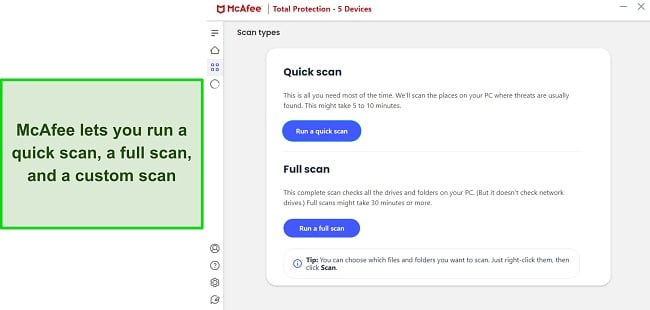
During tests, McAfee successfully detected and removed 100% of the malware on my system. Its full scan took longer than Panda’s, but it also scanned more files, so it gave me greater peace of mind.
Panda’s scans, on the other hand, consist of the following:
- Critical area scan — Similar to McAfee’s quick scan, this scans critical system areas, including the memory and active processes.
- Full scan — Runs a system-wide scan to look for threats across your entire system.
- Custom scan — Lets you specify the files and folders you want to scan.
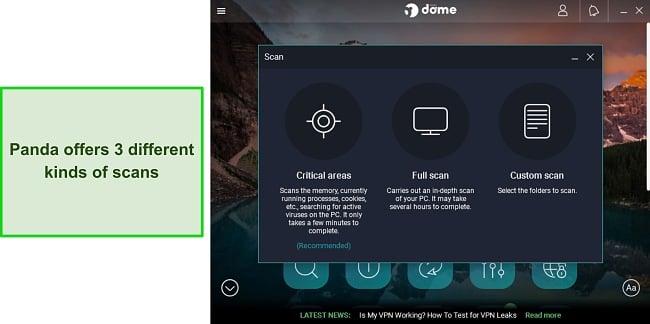
Panda’s scan results are very impressive as well. During tests, Panda detected most malware on my system and had a detection score of 99.7%. The full scan was quicker than McAfee’s, but, as mentioned earlier, it also scanned fewer files. Plus, it had a few false positives, so I’m not entirely confident in its results.
Although both antiviruses effectively remove malware from your system via scans, McAfee wins here. It has a perfect 100% malware detection rate and is much more thorough with its full scans.
Secure your system with McAfee
2. Real-Time Malware Protection — McAfee Provides Much More Effective Real-Time Protection
McAfee easily outperforms Panda when it comes to real-time protection because it blocks 100% of threats in real-time. Panda isn’t bad by any means, but it misses a few threats, so it doesn’t provide 100% protection like McAfee.
I tested Panda and McAfee’s real-time protection by visiting malicious sites and intentionally downloading malware onto my system. McAfee’s real-time protection detected all threats and eliminated them before they could affect my system. Panda also detected most threats, but it let a few slip by, so its protection isn’t perfect.
I also used various EICAR malware samples to see if these antiviruses could detect them. McAfee detected and blocked every malware sample, while Panda let one of the samples slip by. So, while both antiviruses offer reliable real-time protection, McAfee is the better choice here because it catches 100% of threats.
Real-Time Malware Protection Winner: McAfee
Secure your system with McAfee
3. System Performance — McAfee Uses System Resources More Efficiently
I tested Panda and McAfee extensively to monitor which antivirus has less of an impact on my overall system performance. After concluding my tests, I learned that McAfee is much more efficient at using system resources.
To observe how much these antiviruses affect system performance, I ran a full scan and checked how many resources they used in the process. The first thing I noticed is that McAfee occasionally used 100% of my CPU during its full scan, while Panda’s usage remained below 50%. However, McAfee scanned around 392,000 items during its full scan, while Panda only scanned roughly 240,000. So, McAfee’s scans are much more comprehensive, even though they use more resources.
Something odd that I noticed, though, is that Panda often uses system resources even when idle. Panda’s memory usage sometimes spiked past 50% even when I wasn’t running any scans, while McAfee’s memory usage percentage remained in the single digits while idle.
Overall, while McAfee often uses more resources while running scans, it’s still better at using system resources. It scans more files during its full scans and uses fewer resources while idle, so it wins in this category.
System Performance Winner: McAfee
Try McAfee risk-free for 30 days
4. VPN — Panda’s Built-in VPN Delivers Fast Speeds and Is Great for Streaming
I was quite pleased with the results when I tested the VPNs available in both antiviruses, but Panda’s VPN is the superior overall choice. It’s slightly faster than McAfee’s Safe Connect VPN in terms of speeds and is also much more effective at streaming.
Panda’s VPN impressed me with its fast speeds during tests, even on long-distance servers. I only noticed a 10% drop in my base download speeds and a drop of 30% in my upload speeds while connected to Panda’s servers. This meant that my speeds were fast enough to browse the web without slowdowns and stream my favorite shows in HD without buffering.

Panda’s VPN performance doesn’t come as a surprise to me since it’s powered by Hotspot Shield, a renowned name in the VPN space. McAfee’s Safe Connect VPN, on the other hand, is also a decent performer. While connected to its servers, my connection speeds remained fast, and the download speeds only dropped around 15%. However, it’s worth noting that the upload speeds were less than half of what they usually are for me.
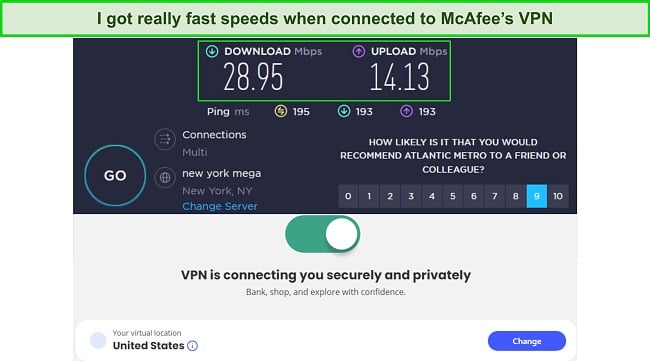
McAfee’s VPN isn’t that good for streaming, either. McAfee Safe Connect is secure and provides fast connection speeds but fails to get around geo-blocks. When I tried to stream Netflix with Safe Connect, it immediately detected that I was using a VPN, and it didn’t let me stream anything.
Overall, while both VPNs offer impressive connection speeds, Panda is the clear winner here because its VPN is far better at streaming.
VPN Winner: Panda
Try Panda risk-free for 30 days
5. Parental Controls — McAfee Offers Thorough and Reliable Parental Controls
Although McAfee and Panda come with their share of parental controls, I found McAfee’s to be a lot more thorough and effective. Panda’s parental controls offer fairly basic content-blocking features, while McAfee’s controls let you do much more, like tracking your kid’s location.
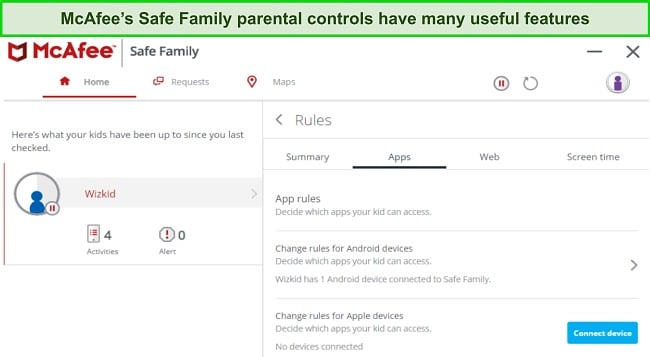
You can effectively use McAfee’s parental controls to safeguard your children. It lets you control the apps and sites your children use and set screen time limits so they don’t use their devices for too long. Plus, it has a location tracking feature that informs you where your child is at all times.
The Safe Family controls in McAfee also give you a detailed history of your kid’s activity. This includes the sites they’ve visited, the apps they’ve used, and more. On the other hand, you can use Panda’s parental controls to block specific websites or certain categories of sites.
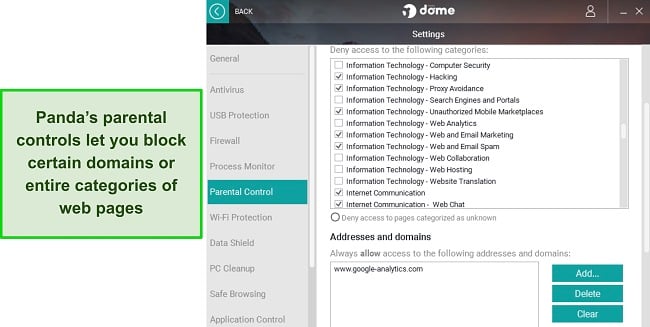
Overall, McAfee’s parental controls are a lot more thorough, so I consider it the clear winner in this category.
Parental Controls Winner: McAfee
Try McAfee risk-free for 30 days
6. Firewall — Both Antiviruses Offer Effective and Customizable Firewalls
I was very impressed by both antiviruses when it comes to their firewalls. McAfee and Panda both offer safe, reliable, and customizable firewalls that’ll keep you safe from any threats.
McAfee’s firewall features an incredibly intuitive design with all its options cleanly laid out. This makes it so that you can easily customize every single part of the firewall to your liking and preferences. You can control what inbound and outbound traffic is allowed, add exceptions for certain apps, and make various other adjustments.
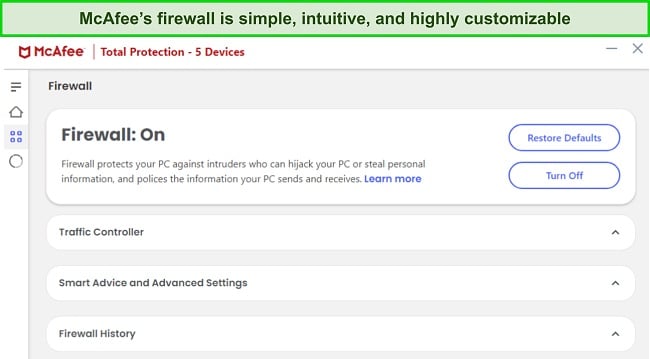
Panda’s firewall is also very customizable and secure but isn’t as intuitive. You can easily customize it by going into the settings, as it offers various options you can adjust to your liking.
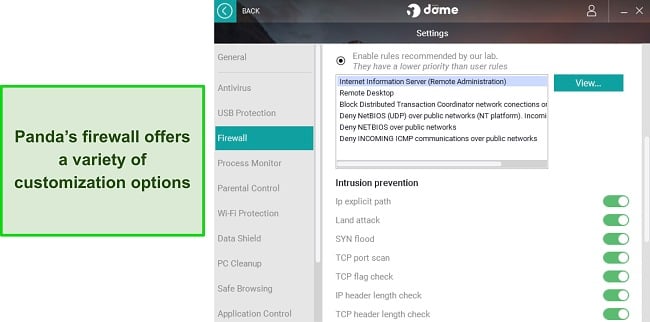
Overall, I’m very pleased with the firewall available in both antiviruses, so I’m calling it a tie here.
Firewall Winner: Tie
7. Password Manager — McAfee’s Password Manager Is Secure and Easier to Use
While both antiviruses come with an effective password manager, I had a much better experience using McAfee to store sensitive credentials. The main reason for this is that it’s a lot easier to set up than Panda’s password manager.
McAfee’s password manager has a very simple setup that opens in your browser and takes a minute to complete at most. Afterward, you can freely use it to store all kinds of sensitive information like logins, card details, addresses, personal notes, and more. However, McAfee’s password manager is missing a secure password generator, which can be a very useful tool at times.
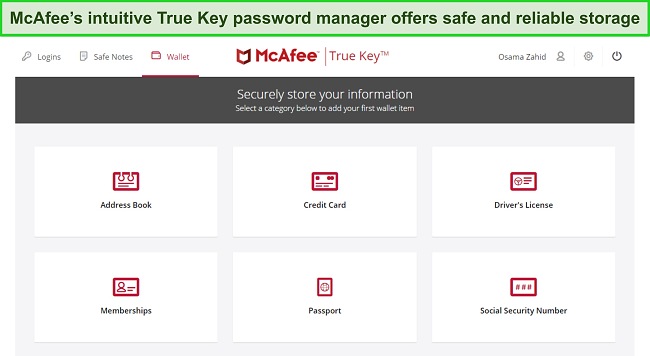
Panda’s password manager takes longer to set up because you must sign into Panda’s web portal, get its browser extensions, and log into those extensions. However, once you’ve set it up, it’s effective and useful. You can use Panda’s password manager to save sensitive information and even generate secure passwords when signing up for new websites.
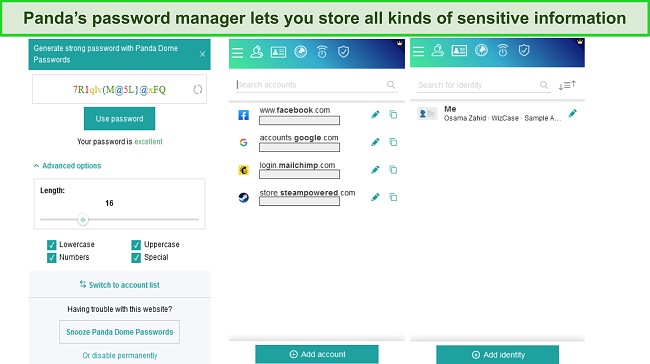
Between both options, I consider McAfee the more secure choice because it uses AES 256-bit encryption to safeguard your information. The encryption used in Panda’s password manager is unknown, so there’s no way to tell for sure how safe it is. So, since McAfee’s password manager is easier to use and offers industry-standard AES 256-bit encryption, it’s the winner here.
Password Manager Winner: McAfee
Try McAfee risk-free for 30 days
8. Gaming Mode — Panda Is the Only Option Between the Two with a Gaming Mode
Panda is the better choice if you want an antivirus with a gaming mode. McAfee doesn’t offer a gaming mode at all, while you can play without interruptions using Panda’s gaming/multimedia mode.
Panda’s gaming mode isn’t necessarily on the same level as what I’ve experienced in other top-tier antiviruses. While it certainly silences notifications to deliver an interruption-free experience, it hardly had any impact on the actual performance of games.
Turning Panda’s gaming mode on didn’t affect my frame rates, so its only real benefit is silencing notifications. If you want an antivirus with a proper gaming mode, Norton’s gaming mode offers noticeable performance improvements, thus leading to a smoother experience.
So, even though Panda’s gaming mode isn’t particularly impactful, it still wins in this category because McAfee doesn’t even offer one.
Gaming Mode Winner: Panda
Try Panda risk-free for 30 days
9. Optimization Tools — McAfee’s Optimization Tools Deliver More Noticeable Improvements
I found various optimization tools in both McAfee and Panda. However, after testing all the available tools thoroughly, I learned that McAfee’s optimization tools offer a much more significant performance benefit.
McAfee’s primary optimization tool is its App Boost. It’s a really useful feature that works by prioritizing apps according to how much processing power they need. What’s great about this tool is that it automatically monitors your frequently used apps and applies the necessary optimizations. McAfee’s App Boost made my apps load noticeably faster, so I’m quite impressed with its performance.
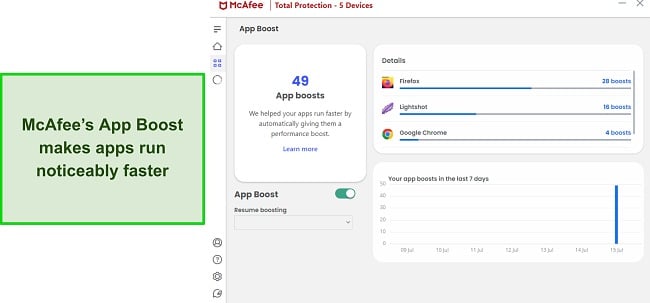
Panda’s main optimization tool is the PC Cleanup tool which helps you defragment your drives, manage which apps run at startup, and free up space. PC Cleanup is great at freeing up much-needed space on my system and defragmenting drives, but it isn’t as impactful as McAfee’s App Boost.
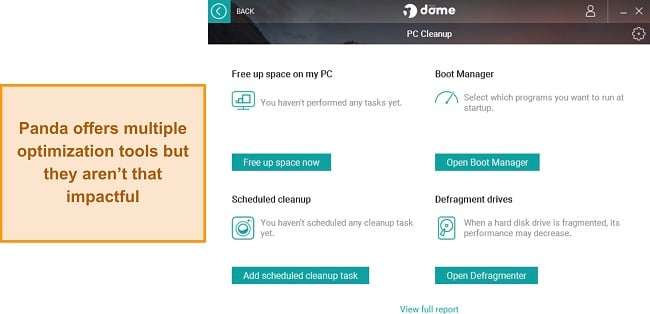
Overall, since McAfee’s optimization tools deliver a more noticeable performance improvement, it’s the clear winner here.
Optimization Tools Winner: McAfee
Try McAfee risk-free for 30 days
10. Other Features — McAfee Is the More Feature-Rich Option Between the Two
McAfee and Panda both come with various extra features that provide additional layers of security and other benefits. However, between the two, McAfee’s extra features feel much more useful and impactful. McAfee offers a mix of security and optimization features that provide significant benefits.
I like the File Shredder tool in McAfee, which lets you securely delete files to ensure they can’t ever be accessed again. The File Shredder has multiple modes, depending on how secure you want to be, and is a great way to remove sensitive data securely.
How to Use McAfee’s File Shredder on Windows
- Open McAfee’s app — Launch the McAfee app on your Windows device.
![Opening McAfee's Windows app]()
- Open the My Protection menu — Navigate to the My Protection menu using the icon on the sidebar.
![My Protection menu in McAfee's Windows app]()
- Open McAfee’s File Shredder — Scroll past the various options and click on File Shredder when you arrive at it.
![Opening the File Shredder in McAfee's app]()
- Specify what you want to shred — Pick the files and folders you want to shred and then click on the shred type. Complete shred is the most secure out of all options.
![Specifying shredding options in the McAfee File Shredder]()
That’s all you need to do. With these steps, you safely shred files so no one else can access them afterward.
There’s also dark web monitoring to track and inform you if any of your sensitive credentials get leaked in data breaches. Plus, McAfee has a useful vulnerability scanner that checks all your apps and your OS to ensure that everything is up to date. This makes sure that your system never has any vulnerabilities that malicious parties could exploit.
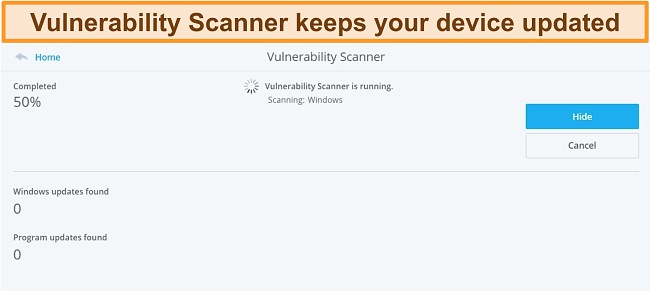
Panda also has its share of extra features, such as the application control menu, which gives you deeper control over the apps that are installed and run on your system. There’s also a process monitor which is essentially a much more in-depth task manager that informs you how safe each running process on your system is.
I was also very pleased with Panda’s helpful anti-theft tools that let you pinpoint your device’s current location if it’s ever lost or stolen. The anti-theft tools let you lock and wipe your device remotely, take a picture if someone tries to unlock it, and even provide motion alerts.
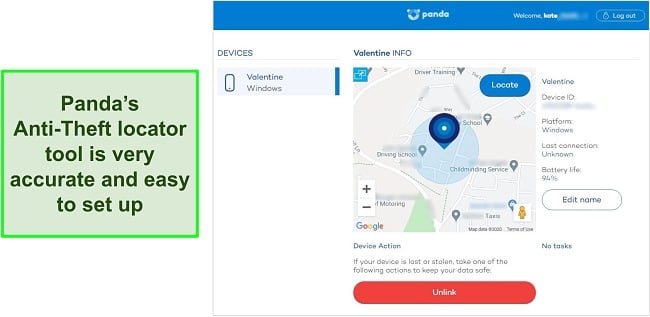
All things considered, both antiviruses impressed me in terms of additional features, but McAfee is the clear winner here. Its extra features simply offer much more benefits than Panda’s do.
Other Features Winner: McAfee
Secure your devices with McAfee
11. Device Compatibility — Both Antiviruses Work on a Wide Range of Platforms
Both of these antiviruses are great options if you want an antivirus that’s compatible with a wide range of devices. I was pleased to learn that McAfee and Panda offer apps for Windows, Android, iOS, and macOS. So, you can easily use either antivirus to secure all your devices, regardless of platform.
It’s worth noting that Panda’s iOS app only offers its built-in VPN, anti-theft, and parental control solutions. On the other hand, McAfee’s iOS app offers multiple security features like ID protection, Secure VPN, Safe Browsing, and more. Thus, I consider McAfee’s iOS app superior to Panda’s.
Both McAfee and Panda offer plans with protection for unlimited devices, and I consider this a tie. However, I feel that Norton is the superior choice here. Its protection is only for up to 10 devices, but its plans offer far better value for money, meaning better protection for all your devices.
Device Compatibility Winner: Tie
12. Customer Service — McAfee’s Reliable Customer Support Is Readily Available at Any Time
Both antiviruses claim to offer 24/7 customer support via live chat and over the phone, but only McAfee lived up to this claim during my tests. McAfee offers reliable phone and live chat support that you can contact at any time. I contacted McAfee’s support through its live chat and connected to an agent in minutes, who then provided helpful answers to my questions.
Panda also offers 24/7 live chat, but it wasn’t nearly as helpful as McAfee’s. When I contacted Panda’s support via live chat, I didn’t get any helpful answers to my queries. Instead, I was given phone numbers that I could contact if I wanted assistance.
There are also online knowledge bases for both antiviruses that you can consult if you need help with the basics. These knowledge bases have lots of useful information that you can use to get either antivirus fully up and running.
Overall, I consider McAfee the winner when it comes to customer service because its support is always available and consistently provides helpful responses.
Customer Service Winner: McAfee
Try McAfee risk-free for 30 days
13. Price — McAfee’s Plans Offer Better Value for Money
Although both McAfee and Panda offer a variety of well-priced plans, I consider McAfee a better option in terms of value for money. Not only do you get perfect 100% malware detection rates with McAfee, but you also get various additional features that make it worth every penny.
McAfee comes with the following plans:
- Antivirus Plus — Comes with McAfee’s core antivirus features and web protection.
- Total Protection Basic — Offers McAfee’s core antivirus functionality, web protection, ID monitoring, firewall, password manager, file shredder, and built-in VPN. Unfortunately, this plan only secures a single device.
- Total Protection Plus — Includes all of Basic’s features but lets you protect up to 5 different devices simultaneously.
- Total Protection Premium — Has all the features included in the Plus plan but also includes the Personal Data Cleanup feature that helps remove your data from high-risk websites.
- Total Protection Advanced — The Advanced plan comes with all of the features mentioned above. Also, it includes ID theft coverage, lost wallet protection, and a security freeze preventing unauthorized people from opening accounts in your name.
Panda also offers multiple affordable plans you can choose from. Excluding the free plan, its main offerings include:
- Panda Dome Essential — Comes with Panda’s core antivirus functionality, 150MB/day VPN, built-in firewall, and WiFi protection.
- Panda Dome Advanced — Has all of the features in Essential but also includes parental controls, ID protection, and ransomware protection.
- Panda Dome Complete — Includes all the features in the Advanced plan and includes Panda’s Data Shield, password manager, and Cleanup optimization tool.
- Panda Dome Premium — Has all the features mentioned above and also offers an unlimited VPN, premium 24/7 support, and an update manager that keeps your system up-to-date.
You can subscribe to Panda’s plans on a monthly, 1-year, 2-year, or 3-year basis. On the other hand, McAfee only offers yearly plans. Another reason why I consider McAfee’s plans better value for money is that you get unlimited device support on its Premium and Advanced plans automatically. However, if you subscribe to Panda, you have to pay extra depending on how many devices you want to use it on.
Overall, McAfee is better when it comes to pricing because each of its plans offers superior value for money compared to Panda’s similar offerings.
Price Winner: McAfee
Try McAfee risk-free for 30 days
14. Free Version — Panda Offers a Somewhat Limited Yet Effective Free Plan
While both antiviruses offer a 30-day free trial, only Panda comes with a truly free plan that you can use. It’s worth noting, though, that Panda’s free plan only offers protection for Windows and Android. So, you can’t use Panda Free to protect your iOS or macOS devices.
Of course, Panda’s free plan isn’t as feature-rich as its premium offerings, but it provides impressive protection nonetheless. It offers real-time protection for your Windows and Android devices while also letting you run scans to detect malware. Panda’s free plan also comes with its built-in VPN, but it’s limited to 150MB/day.
Since Panda is the only choice here with a completely free plan, it takes the win in this category.
Free Version Winner: Panda
Protect your devices for free with Panda
15. Money-Back Guarantee — You Get a Month-Long Money-Back Guarantee With Both Choices
McAfee and Panda both offer reliable money-back guarantees that’ll let you test either choice risk-free before you commit to a full purchase. You get a 30-day-long money-back guarantee with either option, and I was pleased to learn that both antiviruses fully live up to it.
Getting my refund from McAfee was incredibly easy because all I had to do was request a refund through their customer support page. Afterward, an agent called me on my given phone number and processed my refund immediately. I had the money back in my account within 7 business days of refunding McAfee.
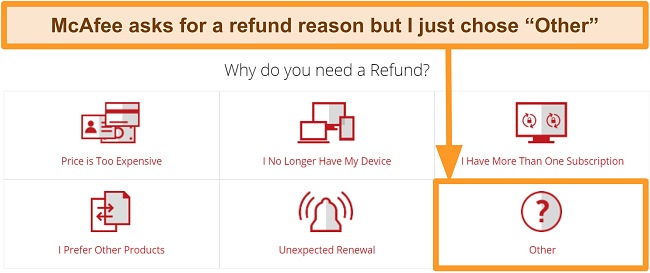
Panda’s refund isn’t as easy because you have to fill out a web form to start the process, but it was a fairly smooth experience overall. I requested a refund and received an email response a few hours later confirming my refund request. The support team mentioned that it’d take 10 business days to get the refund, but Panda refunded my money in 8 days.

Since both antiviruses offer a 30-day-long money-back guarantee and fully live up to it, it’s clear that it’s a tie between the two here.
Money-Back Guarantee Winner: Tie
And the Winner Is… McAfee
While Panda does have a free plan and a better VPN, McAfee outperforms it in all other categories. McAfee is the better choice here with its perfect malware-detection scores, superior parental controls, and a larger variety of additional features.
- Virus Scanner — McAfee
- Real-Time Malware Protection — McAfee
- System Performance — McAfee
- VPN — Panda
- Parental Controls — McAfee
- Firewall — Tie
- Password Manager — McAfee
- Gaming Mode — Panda
- Optimization Tools — McAfee
- Other Features — McAfee
- Device Compatibility — Tie
- Customer Service — McAfee
- Price — McAfee
- Free Version — Panda
- Money-Back Guarantee — Tie
Regardless of whether you decide to go with McAfee or Panda, you’ll be pleased either way. Both antiviruses offer strong protection against threats, secure firewalls, built-in VPNs, parental controls, and more.
I have to highlight, though, that McAfee is the superior choice in most cases. McAfee is recommended for its comprehensive threat detection, robust parental controls, and user-friendly password manager. It provides a guaranteed full-proof protection against all potential threats. Plus, you can try McAfee risk-free with its 30-day money-back guarantee.
Of course, Panda also has its strengths. Panda’s built-in VPN powered by Hotspot Shield is a much better performer than McAfee’s Safe Connect VPN. Also, unlike McAfee, Panda comes with a truly free plan that consists of its core antivirus features. You can also try out Panda’s premium plans completely risk-free with its 30-day money-back guarantee.
All things considered, while I was impressed with how well both antiviruses did in my tests, I have to give the win to McAfee. It delivers superior value for money, more features, and flawless 100% malware detection rates.
Overall Winner: McAfee
Try McAfee risk-free for 30 days
FAQs About McAfee and Panda
Is McAfee better than Panda?
Do I need an antivirus to protect my computer?
While Microsoft Defender offers decent base-level protection, it won’t safeguard you against every threat out there. So, it’s best to get a premium antivirus to make sure you’re shielded from all kinds of malware.
Should I use a free antivirus?
Of course, there are other great free antiviruses, but they don’t offer the best possible protection. Plus, they’re usually missing useful features you get in premium antiviruses, like password managers, parental controls, and built-in VPNs.

